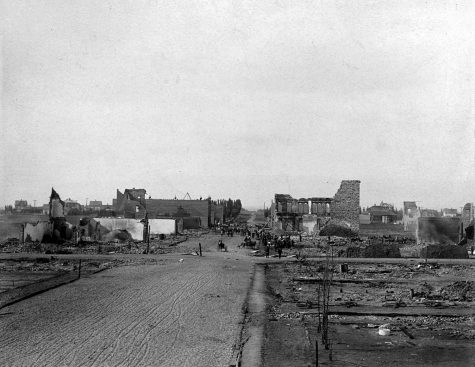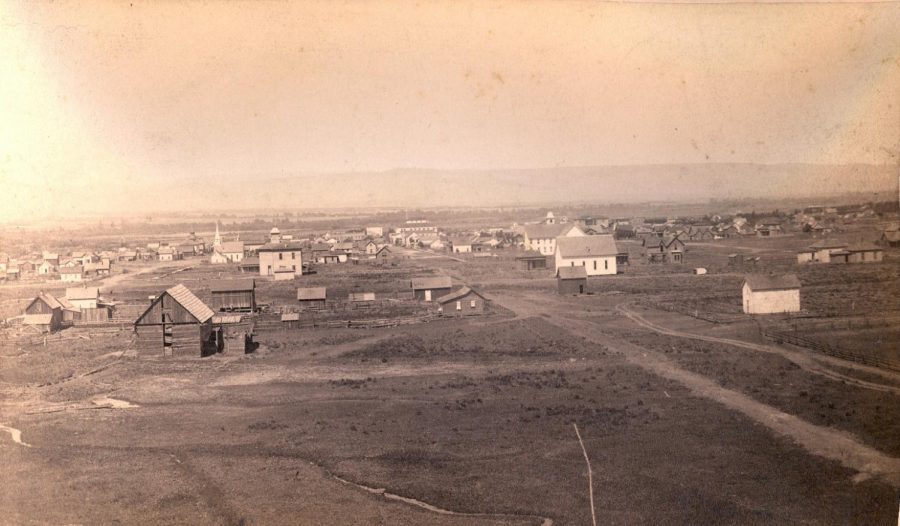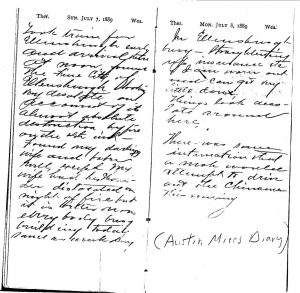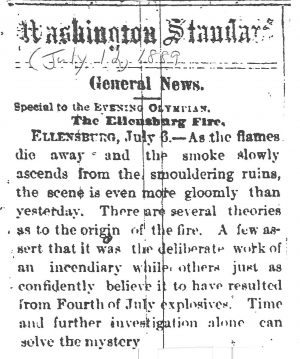Fire Alarm saves the Clymer Museum
Courtesy of the Kittitas County Historical Museum
Aerial from Craig Hill before July 4, 1889: This photograph depicts the young city of Ellensburg, taken before the fire from Craig’s Hill, between 3rd Avenue (to the left) and 4th Avenue (on right). The big white building slightly right of center is the Johnson House (it looks like a three-tiered cake). That building was located on the northwest corner of West 4th Avenue and North Pearl Street (today where Rotary Pavilion is), and was where patrons attending a dance first noticed the J. S. Anthony building on fire.
April 14, 2021
Fire has seared itself into the annals of Ellensburg. From the great fire on July 4, 1889, which destroyed nearly 200 homes, and the more recent fire at the Clymer Museum, which resulted in an estimated $5000 in damages, history has found a way to repeat itself.
For the Clymer Museum, forethought and preparation proved valuable enough to stave off total disaster.

In just under 10 minutes, Kittitas Valley Fire and Rescue (KVFR) responded to a fire alarm at the Clymer Museum located at 416 N. Pearl St., at approximately 2:20 a.m. Monday, March 29. It took less than 30 minutes for KVFR to subdue the flames, preserving the museum’s near $3.6 million dollar collection of art by their namesake, John F. Clymer, located on the first floor.
“We have signs of a burnt floor on the roof where the flames started … There was smoke in the second-floor offices … but the smoke did not get down, and the fire did not get down to the first floor,” Vice President of the Clymer’s board, Jim Pappas said.
However, KVFR did not work alone in preserving Ellensburg’s historic Clymer Museum.

A press release issued by KVFR states, “We would like to emphasize the value of fire alarm systems and can point to this example as a situation where the automated fire alarm system may have saved this historic building and other historic structures neighboring it.”
The Clymer Museum had invested a portion of its resources into a fire alarm system. However, according to the President of the Washington Museum Association and Museum Director of Kittitas County Historical Museum Sadie Thayer, not all Washington museums have taken the same precautions.
“Aberdeen Museum, in 2018, lost their entire structure for their lack of fire alarms,” Thayer said. “It is only thanks to the senior center which rented a portion of the building that had smoke alarms that they managed to find out there was a fire.”

Aberdeen Museum, previously located in Aberdeen, WA, was operating without modern fire detection. To paint a picture of how that might look, Thayer described how local firefighters might have responded in a time without the luxury of modern technology, specifically to the Ellensburg fire in 1889.
“We had a volunteer fire department … word was communicated to them, probably by people on horseback … pretty much word of mouth is the only way people are getting told about the fire, folks from outside of town seeing the glow are rushing into the community to help,” said Thayer.
Many museums operate with limited budgets and rely on volunteer staff. Staying afloat ends up taking precedence over the possibility of burning down.
With museum patronage being at an all-time low due to the coronavirus pandemic, many organizations are struggling now more than ever. People interested in preserving these institutions can do so by visiting their local museums, perusing the gift shops and spreading the word on the value of small-town museums with friends and family.











